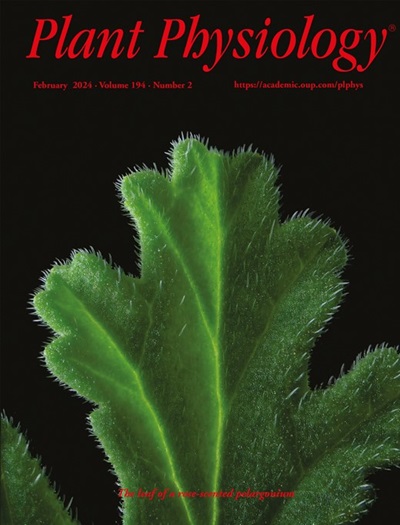puubl5介导的锌指蛋白1的稳定性对干旱胁迫下乌苏杨根系发育至关重要。
IF 6.5
1区 生物学
Q1 PLANT SCIENCES
引用次数: 0
摘要
c2h2型锌指蛋白(ZFP)转录因子影响根系生长发育。然而,它们在抑制树木不定根(AR)和侧根(LR)形成中的潜在作用尚不清楚。本文报道了aba响应型c2h2型锌指蛋白转录因子(PuZFP1)调控乌苏杨根系发育,增强其抗旱性。PuZFP1通过结合PuWRKY46启动子并抑制其表达而负性调控LR的发育。同时,PuZFP1通过抑制进化枝E生长调节(EGR) 2C型蛋白磷酸酶(PuEGR1)促进AR伸长。在过表达puzfp1的细胞系中,分化区(DZ)较高的ABA/IAA比值驱动puwrky46介导的LR抑制。相反,较低的ABA/IAA比值与AR伸长和下游靶基因PuEGR1在伸长区(EZ)的表达有关。值得注意的是,PuZFP1与泛素样蛋白5 (PuUBL5)物理相互作用,并经历26S蛋白酶体介导的降解。综上所述,我们的研究结果揭示了PuUBL5-PuZFP1模块在干旱胁迫下通过ABA/生长素信号介导白杨根系萌发和AR伸长之间的串扰中的作用,并为puzfp1介导的白杨根系生长的调控网络提供了新的思路。本文章由计算机程序翻译,如有差异,请以英文原文为准。
PuUBL5-mediated ZINC FINGER PROTEIN 1 stability is critical for root development under drought stress in Populus ussuriensis.
C2H2-type zinc finger protein (ZFP) transcription factors influence root growth and development. However, their potential roles in inhibiting adventitious root (AR) and lateral root (LR) formation in trees remain unclear. Here, we report that the ABA-responsive C2H2-type zinc finger protein transcription factor (PuZFP1) regulates Populus ussuriensis root development to enhance drought tolerance. PuZFP1 negatively regulates LR development by binding to the PuWRKY46 promoter and inhibiting its expression. At the same time, PuZFP1 promotes AR elongation by repressing Clade E Growth-Regulating (EGR) Type 2C protein phosphatases (PuEGR1). In PuZFP1-overexpressing lines, a higher ABA/IAA ratio in the differentiation zone (DZ) drives PuWRKY46-mediated LR inhibition. Conversely, a lower ABA/IAA ratio is associated with AR elongation and the expression of the downstream target gene PuEGR1 in the elongation zone (EZ). Notably, PuZFP1 physically interacts with Ubiquitin-like protein 5 (PuUBL5) and undergoes 26S proteasome-mediated degradation. Taken together, our findings shed light on the role of the PuUBL5-PuZFP1 module in mediating the crosstalk between LR emergence and AR elongation via ABA/auxin signaling in drought-stressed P. ussuriensis, and provide insights into the regulatory network underlying PuZFP1-mediated root growth in poplar.
求助全文
通过发布文献求助,成功后即可免费获取论文全文。
去求助
来源期刊

Plant Physiology
生物-植物科学
CiteScore
12.20
自引率
5.40%
发文量
535
审稿时长
2.3 months
期刊介绍:
Plant Physiology® is a distinguished and highly respected journal with a rich history dating back to its establishment in 1926. It stands as a leading international publication in the field of plant biology, covering a comprehensive range of topics from the molecular and structural aspects of plant life to systems biology and ecophysiology. Recognized as the most highly cited journal in plant sciences, Plant Physiology® is a testament to its commitment to excellence and the dissemination of groundbreaking research.
As the official publication of the American Society of Plant Biologists, Plant Physiology® upholds rigorous peer-review standards, ensuring that the scientific community receives the highest quality research. The journal releases 12 issues annually, providing a steady stream of new findings and insights to its readership.
 求助内容:
求助内容: 应助结果提醒方式:
应助结果提醒方式:


